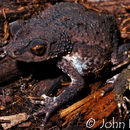Description
provided by AmphibiaWeb articles
These yellowish-brown pebbly-skinned toads range from 64-120 mm SVL. The venter is yellowish. They have gold marbled eyes. Both males and females have prominent crests above their eyes and upturned snouts. Females have rougher skin and higher crests than males, and lack nuptial pads on the first fingers. Females are also generally larger than males, reaching a maximum of 120 mm in SVL vs. 85 mm SVL for males. Males are also generally more yellowish in color (Matos-Torres 2006).This species was first described by Cope (1868). In Puerto Rico, this toad is called Sapo concho (Stuart et al. 2008).
- Cope, E. D. (1868). ''Sixth contribution to the herpetology of tropical America.'' Proceedings of the Academy of Natural Sciences of Philadelphia, 20, 305-312.
- Johnson, B. (1999). ''Recovery of the Puerto Rican Crested Toad.'' Endangered Species Bulletin, XXIV, 8-9.
- Matos-Torres, J. J. (2006). Habitat Characterization for the Puerto Rican Crested Toad (Peltophryne [Bufo] lemur) at Guánica State Forest, Puerto Rico. M. S. thesis. University of Puerto Rico, Mayagüez Campus.
Distribution and Habitat
provided by AmphibiaWeb articles
Puerto Rican Crested Toads are found in Puerto Rico. Originally it was found in several localities along the north and south coasts, but it is now restricted to a single locality on the south coast, in Guánica State Forest (Matos-Torres 2006). The range also formerly included the nearby islands of Virgin Gorda and St. John in the British Virgin Islands, but these populations have been extirpated (Johnson 1999; Stuart et al. 2008). Puerto Rican Crested Toads inhabit semi-arid areas and are mostly found in rocky limestone outcrops within seasonal evergreen forest at elevations from 0-50 m asl (Matos-Torres 2006).
Life History, Abundance, Activity, and Special Behaviors
provided by AmphibiaWeb articles
Reproduction is sporadic and highly dependent upon rainfall. These toads breed in temporary or permanent pools (Stuart et al. 2008). The females lay long, black strands of eggs, with up to 15,000 eggs per strand. It takes about 18 days for tadpoles to mature into toadlets. The adult diet generally consists of worms, insect larvae, insects, and other invertebrates.
Life History, Abundance, Activity, and Special Behaviors
provided by AmphibiaWeb articles
This species has always been rare (Matos-Torres 2006). Currently it is Critically Endangered and is now found only in a single locality; as of 2003, only 80 adults were counted at that locality (Stuart et al. 2008). The main factor leading to the decrease of Bufo lemur populations has been the destruction of their breeding grounds. Preservation of these sites is necessary to prevent the extinction of this species. Captive breeding programs are also critical and are currently being implemented for Bufo lemur, under an American Zoological Association Species Survival Plan, or SSP. This species was the first for which a Species Survival Plan was set up (Johnson 1999). The SSP protected a breeding site in both northern and southern Puerto Rico. The northern breeding site was not protected and no toads have been seen there since 1988. The southern site has been protected, however only about 1,000 adult toads have been observed there. Over the time that the SSP has been working with this amphibian, the population of B. lemur at the southern site has decreased to around 200 adults (Johnson 1999). Another contributor to the decline of B. lemur has been the introduction of the Giant Marine Toad (Bufo marinus), which competes for breeding sites, food, and general habitat. The purpose of the introduction (which took place in the 1920s) was to control sugar cane grubs Rats and the Indian mongoose are also believed to compete with B. lemur (Johnson 1999).
Relation to Humans
provided by AmphibiaWeb articles
Habitat loss due to urban development is a major threat. A major breeding pool in the south was drained out in order to provide more area for parking spaces at the beach (Stuart et al. 2008)

